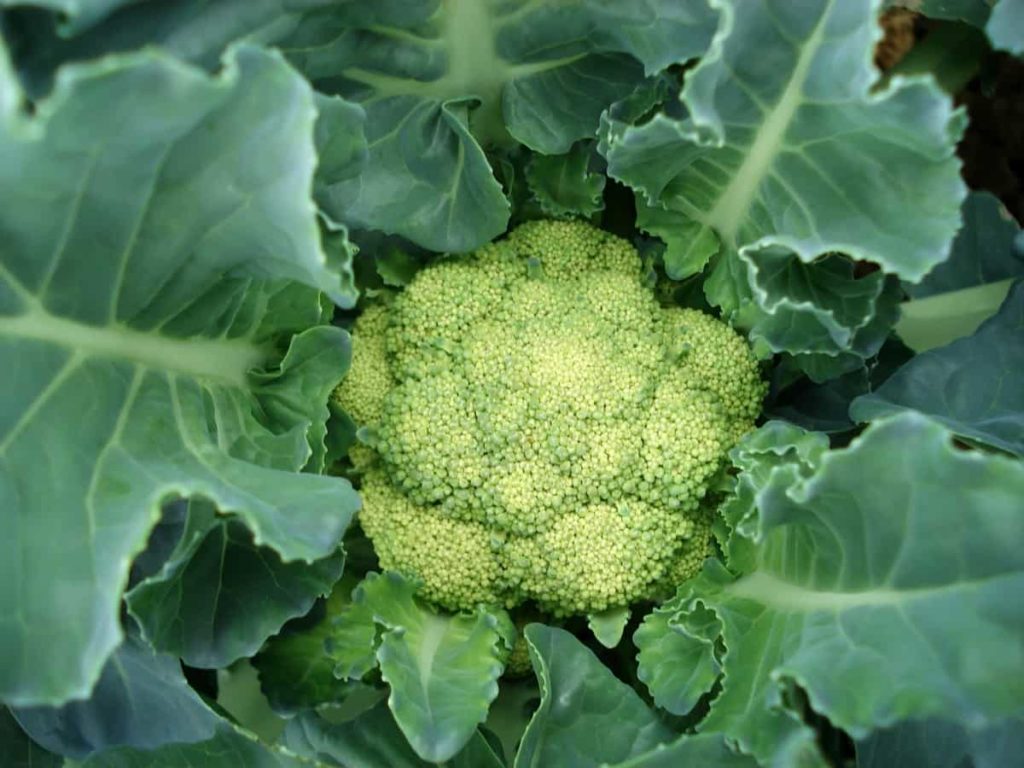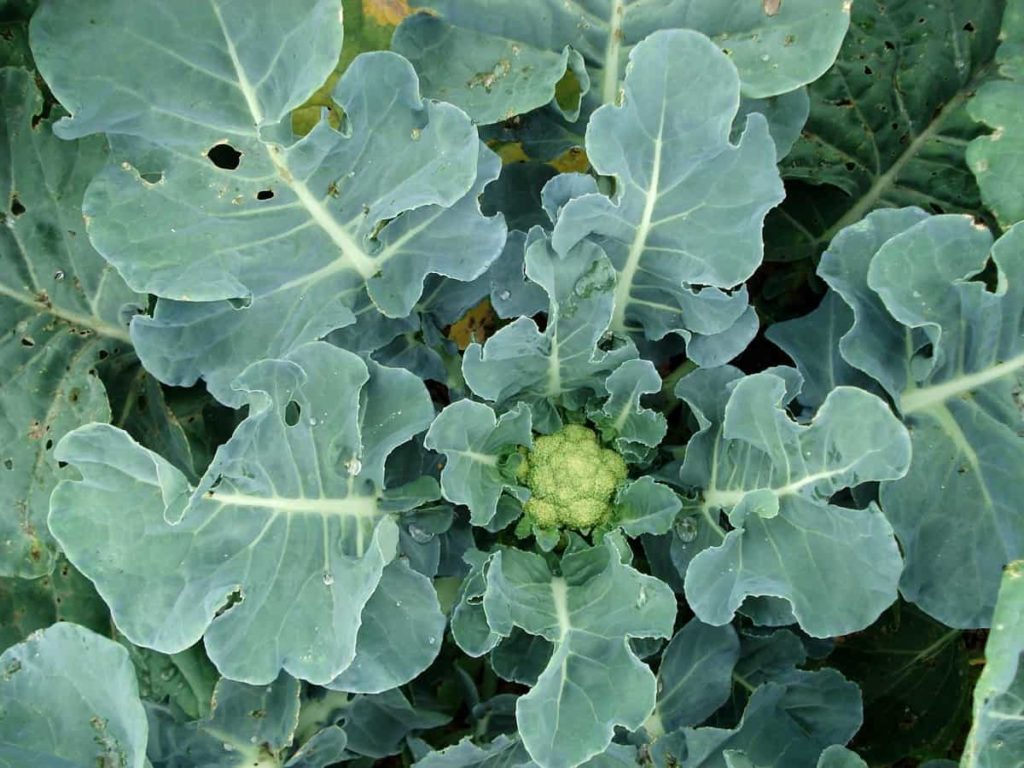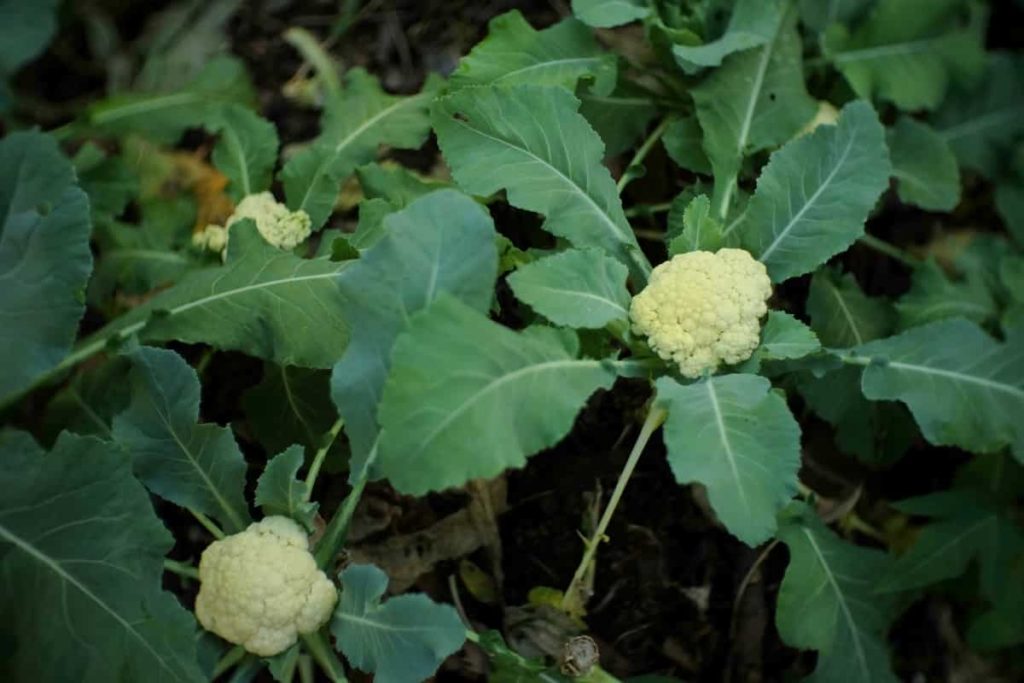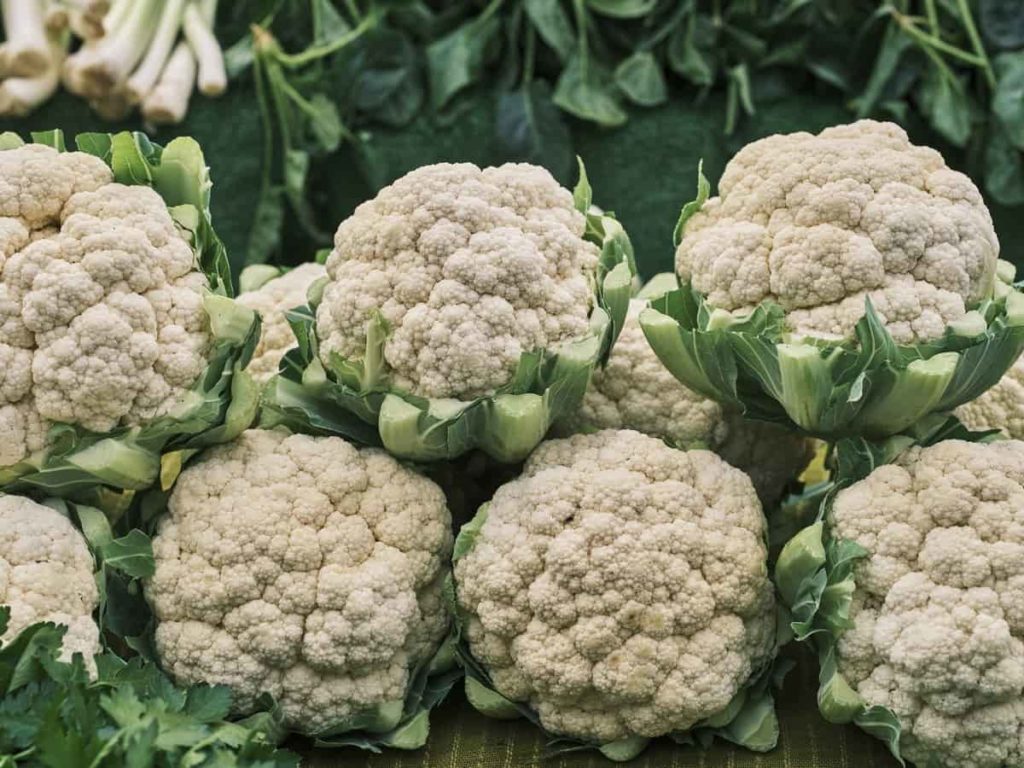Cauliflower likes the sun, but is a cold-weather crop, and needs specific conditions to thrive. Fertilizer and manure requirements for Cauliflower crops depend on soil fertility. Soil testing should be done before starting Cauliflower cultivation to determine the fertility of the land. Let’s check out the best fertilizer for Cauliflower.

Cauliflower is a simple growing plant and doesn’t need much care, but if you want your Cauliflower crop to thrive, you’ll need to give it some nutrients during its growing season. Fertilizing is one of the best ways to ensure that your plants get all the essential nutrients needed for healthy growth. The trick of successfully growing Cauliflower is to add fertilizers before planting and regularly when the plant is reaching its maximum size.
Natural fertilizers are perfect for your garden and going organic will make your plants happy and support your garden to find a natural balance of soil germs, and insects for large crops. Fertilizing Cauliflower can result in larger and more abundant heads. Proper fertilization will also help improve your Cauliflower taste. Fertilizers can also increase resistance to plant diseases.
Best fertilizer for Cauliflower
Compost manure for Cauliflower
Aged cow manure
Dig the aged cow manure in the soil before planting Cauliflower seedlings. This will include carbon-rich organic material in the soil to improve soil structure and drainage. It will also attract and grow good bacteria and insects that will aerate the soil to encourage good root development.
Worm castings
Mix the worm casting of the insect through the soil before planting Cauliflower to add extra structure to the ground. The casting of the insect will also have good bacteria that will feed the insects in your soil.
In case you miss this: Cauliflower Questions and Answers, Planting FAQs

Compost
Homemade or purchased manure can be mixed by the soil before planting Cauliflower with a rate of about 1 shovel per plant. This will improve soil water-holding capacity, nutrients and add extra nitrogen to your soil for good leaf growth.
Organic fertilizers for Cauliflower
Pelleted chicken manure
Mix 1 handful of pelleted chicken manure in the soil for each Cauliflower seedling before planting. Add 1 handful of pellet chicken manure around the root area every 4 weeks as the plant is growing and water well.
Blood and bone meal
Use blood and bone-based fertilizer every 4 weeks after planting Cauliflower unless you see the shape of a flower head. Use blood and bone instead of pelleted chicken manure as both will benefit plants in the same way. Blood and bone have slightly more calcium so can produce strong stems.
Homemade fertilizers for Cauliflower
Cauliflower needs very fertile soil, which contains plenty of nitrogen. You can do this by providing coffee grounds to your Cauliflower bed and giving it more nitrogen organic fertilizer once or twice during its life.
In case you miss this: Growing Cauliflower In Greenhouse – A Planting Guide

Liquid fertilizers for Cauliflower
- Add liquid fertilizer during the early stages of growth to boost your plant growth. Use a light mixture of liquid fertilizer like fish emulation on the growing seedlings to encourage rapid growth and provide additional nitrogen to improve the soil at the same time.
- Cauliflower seedlings are also susceptible to transplant shocks and appreciate weak doses of liquid fertilizer at the time of transplant. Compost tea, manure tea, or fish emulation can all help.
Commercial fertilizers for Cauliflower
NPK
Fertilizer dose depends on soil fertility and the amount of organic fertilizer applied to the crop. Generally, 80 to 120 kg nitrogen, 60 to 100 kg phosphorus, and 60 to 120 kg potassium are applicable. Recommended for maximum production. Half of the dose of nitrogen and the whole amount of P and K are given at this time of Transplant. Balance nitrogen is given six weeks after transplant or when it comes to earthing up.
Cauliflower fertilizer schedule
At the time of soil preparation
Feeding the Cauliflower bed either starts in autumn before you plant Cauliflower seedlings or immediately after starting your seedlings indoors. Cold weather vegetables are usually started indoors at the end of winter, then transplanted to the garden two to six weeks before the last frost of the season.
Fertilizer increases soil fertility and improves soil structure. Set 2 to 3-inch layers of compost on the garden bed in which you will be growing Cauliflower, and spread the compost in 6 to 8 inches of soil above. It is better to improve the soil a few weeks before the time is planting so that the nutrients from compost have to be absorbed throughout the garden bed.
In case you miss this: Cauliflower Seed Germination, Time, Temperature

Additional soil preparation
Cauliflower prefers pH levels from 6.5 to 8.0. If it is below 6.5, the limestone will raise the pH of acidic soil. If your soil is too alkaline, however, there are good amendments sulfur or peat moss to reduce pH which is above 8.0.
After planting
After planting Cauliflower seedlings, bring them to a strong start with compost tea. Compost tea is made by soaking the aged compost in a clean bin of water for at least a day. Either place the manure in the burlap sack before setting it in water, or strain the mixture after one to two days. After adding plenty of clean water to the strained compost solution until it turns very light brown, pour the solution directly onto the Cauliflower seedlings and surrounding soil. Pour this liquid in the morning, on sunny days, so that leaves have a chance to dry.
Mid-season feeding
Once your Cauliflower seedlings make heads; they will appreciate the second fertilizers. Either water them with compost tea as described in the planting section or feed them with dry manure. To use the latter method, known as side-dressing, a narrow band of aged dry compost is spread around 2 inches long and wide along each row of Cauliflower. Water the Cauliflower bed thoroughly after the compost spread at the soil level.
Fertilizing tips for increasing Cauliflower yield
- First, you must take into account the soil condition of your sector by semi-annual or annual soil testing before applying any fertilization procedure. The Cauliflower plant demands heavy fertilization to thrive and produce a well-formed head. Thus, it is considered to be a hungry crop.
- In many cases, producers merge one-third of total nitrogen and the entire amount of potassium and phosphorus into the soil. They can also apply 25 to 40 tonnes of well-digested manure per hectare. Then, they continue by adding the remaining nitrogen divided into two applications. The first application takes place one week after the transplant and the second one after 1 month after the first application.
In case you miss this: Growing Hydroponic Cauliflower, Planting, and Care

- Some experienced farmers recommend a balanced slow-release fertilizer in the form of grains, which consists of essential nutrients, such as nitrogen, phosphorus, and potassium (20-20-20). We can directly add granular fertilizers to the soil level and irrigate. Granular fertilizers should not be touched plants directly, as they are at risk of burning.
- However, most Cauliflower farmers choose the method of fertigation (injection of water-solving fertilizers within the drip irrigation system). In this case, they can put different rates of fertilizers for each day. The growth of Cauliflower is divided into three periods.
- The first period begins with the transplant (day one) and until day 45. During this period, they apply on an average of 1 kg nitrogen, 1 kg P2O5, and 1 kg K2O per hectare.
- The second round starts at 46 days and ends at 70 days. During this period, they increase rates and apply on an average of 3 kg nitrogen, 1.5 kg P2O5, and 3 kg K2O per hectare.
- The third period begins at 71 days and ends with the crop. During this period, they apply on an average of 0.75 kg N and 1 kg K2O per hectare.
- Each sector is different and has different needs. It is very important to check the condition and pH of the soil before applying any fertilization procedure.
In case you miss this: Cauliflower Container Gardening Techniques, Tips

How to fertilize Cauliflower in pots
- To grow Cauliflower in containers, these plants need a loose, light potting mix that holds moisture and nutrients but drains well. Any standard commercial potting soil consisting of ingredients like peat, compost, fine bark, and either vermiculite or perlite works well.
- Never use garden soil, which is rapidly compacted and prevents the air from reaching the roots. Cauliflower plants are heavy feeders. In just a few months, the supply of nutrients can dry up, resulting in stunted development. You want your plant to have enough energy to produce a big head, so regular fertilization is essential.
- Use balanced fertilizer to feed your plant every 3 to 4 weeks. Water-soluble products are best. All you have to do is dissolve the grain according to the instructions and water your plants. Focus your water on the soil around the base of the plant. When applying fertilizers, should not touch the stem. Fertilizer can burn it. Continue applying the plant’s manure throughout its life.
- If you are planting from seedlings, delay a few weeks after planting. Providing fertilizer very quickly can stress the newly transplanted seedlings.
- Flower Garden Designs and Layouts for Beginners
- Planting and Spacing Techniques in Papaya: A Beginner’s Guide
- Growing Gold: Essential Techniques for Planting Pineapples
- How to Make Kalanchoe Plant Bushy: Home Remedies and Solutions
- 11 Reasons Why Your Gardenia is Not Blooming: Home Remedies and Solutions
- Eco Elegance: The Guide to Designing a Drought-Tolerant Landscape
- Gardening on a Slope: Strategies for Hillside Landscaping
- Nourish and Flourish: Top Organic Mulches for Thriving House Plants
- Everything You Want to Know about Indian Mogra Flower: Discover Uses and Growing
- Green Thumb Success: Expert Tips for Cultivating Greenhouse Pumpkins All Year Round
- Maximize Growth & Flavor: The Ultimate Guide to Companion Planting in Herb Gardens
- How to Control Rhododendron Problems Naturally: Home Remedies and Organic Ways to Fix Them
- Natural Magic: The Remarkable Benefits of Cinnamon for Plants
- Best Steps to Revive Dying Tulip with Natural and Organic Treatment
- 10 Reasons Why Your Angel Trumpet is Not Blooming: Remedies and Treatment
- How to Fix Periwinkle Leaf and Flower-Related Problems: Natural Remedies and Solutions
- How to Fix Zinnias Leaf and Flower Problems: Discover Natural and Home Remedies
- Organic Steps to Induce Lemon Tree Flowers: A Comprehensive Guide
- Bloom Booster: Crafting the Perfect Homemade Bougainvillea Fertilizer
- Optimizing Growth: A Guide to Applying NPK Fertilizer for Potted Plants
- 10 Best Homemade Fertilizers for Rubber Plant: DIY Recipes and Application Method
- How to Boost Female Pumpkin Flowers: Effective Steps for More Flowers and High Yields
- Transform Your Indoor Garden: Top Benefits of Pink Salt for Houseplants
- 10 Best Homemade Fertilizers for Peacock Plants (Calathea): Easy DIY Guide
- Unlock Blooms: 9 Reasons Why Your Potted Chrysanthemum is Not Blooming
- 8 Reasons Why Your Potted Hibiscus is Not Blooming: Fix it with Simple Solutions
- Unlock Blooms: 9 Key Reasons Your Potted Frangipani Won’t Flower
- 10 Reasons Why Is My Ice Plant Not Blooming: Remedies and Treatment
- 10 Reasons Why My Potted Hydrangea Not Blooming: Treatment and Remedies
- 10 Reasons Why is My Wisteria Not Blooming: Remedies and Treatment
- 10 Reasons Why is My Goldfish Plant Not Blooming: Remedies and Treatment
- Maximize Your Space: Ultimate Guide to Balcony Gardening with Grow Bags
- 10 Reasons Why Your Iris is Not Blooming: Remedies and Treatment
- 10 Reasons Why Your Anthurium Plant is Not Blooming: Treatment and Remedies
- 10 Reasons Why Your Aquaponic Plants Are Not Flowering: Remedies and Treatment
- 10 Reasons Why Your Agapanthus is Not Flowering: Remedies and Treatment